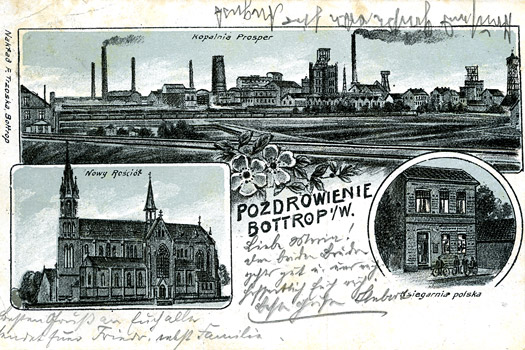
Kirchen für Zuwanderer
Besonders im Bereich Bottrop gab es nach der Abteufung der Zeche Prosper II fast ausschließlich von Polen bewohnte Zechenkolonien mit der entsprechenden Infrastruktur. Die katholischen Kirchengemeinden konnten den polnisch-katholischen Zuwanderern nicht mehr gerecht werden und so kam es zunächst zu Abpfarrungen und später auch zu mehreren Kirchenneubauten
© Abbildung Stadtarchiv Bottrop
Glaube zurück zur Auswahl
Temporary Church, loss of pastoral office and abolition of confessional church structures for immigrants from 1860 to 1930
The pre-industrial division of the Ruhr Region in catholic and protestant areas was already disappearing towards the end of the 19th century as a result of the various waves of migration. This is reflected in the church buildings erected in the beginning of the 20th century.
After the Reformation, the Ruhr Region was divided in(to denominational regions: the County of Mark and the free imperial city of Dortmund were protestant, while the Rhenish regions belonging to Kurköln, Vest Recklinghausen, the regions under the control of the diocese of Münster, and the imperial abbeys Essen and Werden, were predominantly catholic. Only the Duchy of Kleve was of mixed denomination.
These demarcation lines along religious orientation were continually changed by the incipient industrialization:
The permanent need for workforce could not be met by supply from the surrounding regions, and therefore brought immigrants from Hessen, Nassau and other parts of Germany as well as cross-border commuters from Holland to the Ruhr Region.
The existing denominational structures were weakened by the increasing presence of minority religions.
However, at first the spatial structures of major denominations remained in place. Socially, the protestant, Prussian authorities shaped public life in many areas, while the Catholic Church organized the catholic workers and founded social organizations.
The existing structures were crucially changed in the 1870s by the recruitment of frequently Polish origin workforce from the German Eastern Territories (Posnan, Silesia, West and East Prussia).
The "Ruhr Poles" experienced a great amount of prejudice from authorities and older residents, which, on the other hand, strengthened their sense of common identity, and decreased their willingness to integrate.
This gave rise, in years to follow, to a unique Polish-Catholic culture by the Ruhr. Especially around Bottrop, after the opening of the Prosper II mine, emerged miner colonies made up almost exclusively of Poles, and the corresponding infrastructure. Catholic parishes could no longer accommodate the Polish Catholic immigrants, which led first to separate parishes and later to the construction of new churches by, Gelsenkirchen Architect Josef Franke among others, seen as one of the key figures of modern Ruhr Region architecture. His involvement with modern architecture, the liturgy reform in the Catholic Church, and the expressionistic formal vocabulary provided new impetus for architecture in the region.
But not only catholic immigrants from the Eastern Territories brought foreign impulses into the Ruhr region; also those from the Old-Polish speaking, protestant Masuria from East Prussia, who settled in the Rhine Region from the 1880s onwards. As they had been under Prussian rule for centuries and lutheran since the reformation, they clearly set themselves apart from the catholic Poles. In contrast to the catholic Poles, the state considered the Masuria able to integrate, and supported their loyalty to the empire and the Emperor. Starting at least with the Weimar Republic, many Masurians were integrated in the national protestant church. Together with the German-speaking protestant immigrants they contributed greatly to the growth of protestant parishes in the Ruhr Region. Similar to the Catholics this led in turn to the building of numerous churches.
Denkmale zum Impuls
Herne - Masurischer Betsaal
Vor allem um in den neugegründeten Zechen, etwa in der Zeche Mont Cenis, zu arbeiten, kamen ... weiter
Bottrop - Kirchen
Vor allem wegen des prosperierenden Bergbaus kamen ab 1870 zahlreiche Arbeiter aus polnischen ... weiter
Recklinghausen - Evangelische Christuskirche
Die Christuskirche ist die größte evangelische Kirche im ehemaligen Vest ... weiter
Recklinghausen - Gustav-Adolph-Kirche
Nachdem es den Nichtkatholiken ab 1614 verboten war, sich in Recklinghausen niederzulassen, ... weiter
Bottrop - Evangelische Martinskirche
Die Martinskirche steht am Beginn des evangelischen Gemeindelebens in Bottrop. Mit dem starken ... weiter
Bottrop - Zeche Prosper II und Malakowturm
Vor allem wegen des prosperierenden Bergbaus kamen ab 1870 zahlreiche Arbeiter aus polnischen ... weiter
